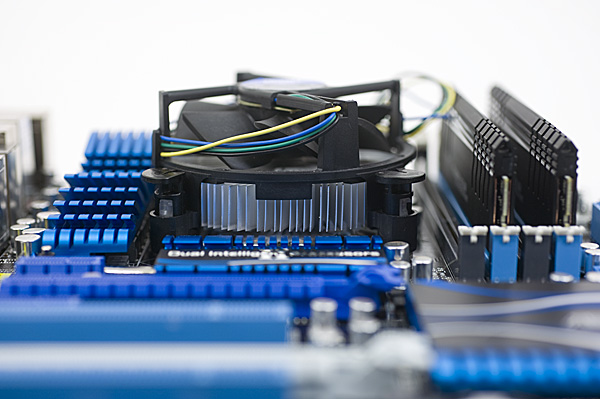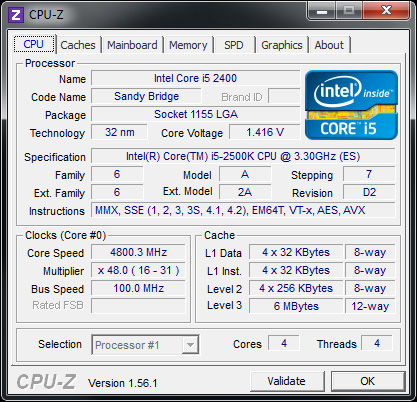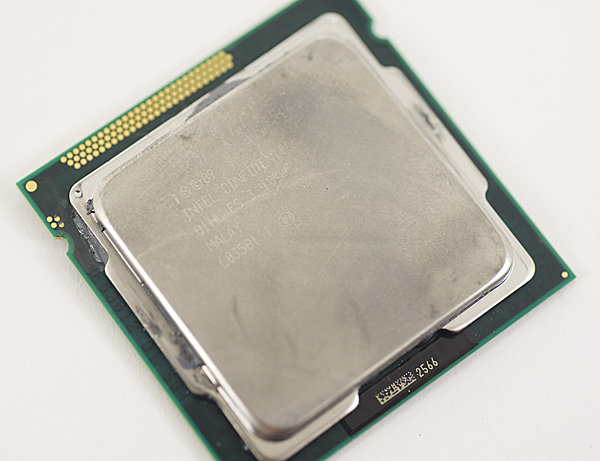The Sandy Bridge Review: Intel Core i7-2600K, i5-2500K and Core i3-2100 Tested
by Anand Lal Shimpi on January 3, 2011 12:01 AM ESTOverclocking, the K-Series and What You’ll Want to Buy
If you haven’t noticed, the computing world is becoming more integrated. We review highly integrated SoCs in our smartphone coverage, and even on the desktop we’re seeing movement towards beefy SoCs. AMD pioneered the integrated memory controller on desktop PCs, Intel followed suit and with Lynnfield brought a PCIe controller on-die as well. Sandy Bridge takes the next logical step and brings a GPU on-die, a move matched by AMD with Brazos and Llano this year.
In the spirit of integration, Intel made one more change this round: the 6-series chipsets integrate the clock generator. What once was a component on the motherboard, the PLL is now on the 6-series chipset die. The integrated PLL feeds a source clock to everything from the SATA and PCIe controllers to the SNB CPU itself. With many components driven off of this one clock, Intel has locked it down pretty tight.
With Nehalem and Westmere, to overclock you simply adjusted the BCLK from 133MHz to whatever speed you wanted and sometimes toyed with multipliers to arrive at a happy end result. With Sandy Bridge, the BCLK generated on the 6-series PCH is at 100MHz by default and honestly won’t go much higher than that.
While I’ve heard reports of getting as high as 115MHz, I’d view 103—105MHz as the upper limit for what you’re going to get out of BCLK overclocking. In other words: next to nothing. A 105MHz BCLK overclock on a Core i7-2600 will take you from a stock speed of 3.4GHz to a whopping 3.57GHz. The form of overclocking we’ve been using for the past decade is effectively dead on Sandy Bridge.
Years ago, before the Pentium II, we didn’t rely on BCLK (or back then it was just FSB or bus overclocking) to overclock. Back then, if we wanted a faster CPU we’d just increase the clock multiplier. Intel has dabbled in offering multiplier unlocked parts for overclockers, we saw this last year with the Core i7 875K for example. With Sandy Bridge, those unlocked parts are going to be a lot more important to overclockers.
It works like this. If you have a part that does not support Turbo (e.g. Core i3-2100 series), then your CPU is completely clock locked. You can’t overclock it at all, have fun at your stock frequency. This is good news for AMD as it makes AMD even more attractive at those price points.
If you have a part that does support turbo (e.g. Core i5-2400), then you have what’s called a “limited unlocked” core—in other words you can overclock a little bit. These parts are limited to an overclock of 4 processor bins above and beyond the highest turbo frequency. Confused yet? This chart may help:
In this case we’re looking at a Core i5-2500, which runs at 3.3GHz by default. When a single core is active, the chip can turbo up to 3.7GHz. If you want, you can change that turbo state to go as high as 4.1GHz (if your CPU and cooling can keep up).
Overclocking these limited unlocked chips relies entirely on turbo however. In the case above, the fastest your chip will run is 4.1GHz but with only one core active. If you have four cores active the fastest your chip can run is 3.8GHz. While Intel didn’t sample any limited unlocked parts, from what I’ve heard you shouldn’t have any problems hitting these multiplier limits.
There’s a third class of part: a fully unlocked K-series chip. At launch there are only two of these processors: the Core i5-2500K and the Core i7-2600K. Anything with a K at the end of it means you get all multipliers from 16x all the way up to 57x at your disposal. It’s effectively fully unlocked.

These chips overclock very well. Both my Core i5-2500K and Core i7-2600K hit ~4.4GHz, fully stable, using the stock low-profile cooler.

This is all you need for 4.4GHz
With a bit more effort and a better cooler, you can get anywhere in the 4.6-5.0GHz range:

It's a bit too early to tell how solid these near-5GHz overclocks will be, but I'm confident in the sub-4.5GHz overclocks we were able to sustain.
You do pay a price premium for these K-series SKUs. The 2500K will cost you another $11 over a stock 2500 and the 2600K costs an extra $23. In the case of the 2500K, that’s a small enough premium that it’s honestly worth it. You pay $11 extra for a chip that is very conservatively clocked and just begging for you to overclock it. Even the 2600K’s premium isn’t bad at all.
| Model Number | Standard SKU | K-Series SKU | Price Premium |
| Intel Core i7-2600 | $294 | $317 | +$23 |
| Intel Core i5-2500 | $205 | $216 | +$11 |
As an added bonus, both K-series SKUs get Intel’s HD Graphics 3000, while the non-K series SKUs are left with the lower HD Graphics 2000 GPU.
Compared to Lynnfield, you’re paying $11 more than a Core i5-760 and you’re getting around 10-45% more performance, even before you overclock. In a perfect world I’d want all chips to ship unlocked; in a less perfect world I’d want there to be no price premium for the K-series SKUs, but at the end of the day what Intel is asking for here isn’t absurd. On the bright side, it does vastly simplify Intel’s product stack when recommending to enthusiasts: just buy anything with a K at the end of it.
Since we’re relying on multiplier adjustment alone for overclocking, your motherboard and memory actually matter less for overclocking with Sandy Bridge than they did with P55. On both P67 and H67, memory ratios are fully unlocked so you can independently set memory speed and CPU speed. Even the GPU ratios are fully unlocked on all platforms and fully independent from everything else.












283 Comments
View All Comments
IanWorthington - Monday, January 3, 2011 - link
Not really: the board manufacturers seem to be adding usb3 chipsets w/o real problems. Good enough.usernamehere - Monday, January 3, 2011 - link
Sure, if you're building a desktop you can find plenty with USB 3.0 support (via NEC). But if you're looking for a laptop, most will still not have it. For the fact that manufacturers don't want to have to pay extra for features, when they usually get features via the chipsets already included. Asus is coming out with a handful of notebooks in 2011 with USB 3.0 (that I know of), but wide-spread adoption will not be here this year.JarredWalton - Monday, January 3, 2011 - link
Most decent laptops will have USB3. ASUS, Dell, HP, Clevo, and Compal have all used the NEC chip (and probably others as well). Low-end laptops won't get USB3, but then low-end laptops don't get a lot of things.TekDemon - Monday, January 3, 2011 - link
Even the netbooks usually have USB 3.0 these days and those almost all use intel atom CPUs. The cost to add the controller is negligible for large manufacturers. USB is not going to be the deciding factor for purchases.DanNeely - Monday, January 3, 2011 - link
Are you sure about that? Newegg lists 99 netbooks on their site. Searching for USB 3 within netbooks returns 0 products.TekDemon - Monday, January 3, 2011 - link
Your claims are pretty silly seeing as how USB came about in the same way that Light Peak did-Intel invented USB and pushed it to legacy ports like PS/2, and slowly phased out support for the older ones entirely over the years. It makes no sense for them to support USB 3.0, especially without a real market of devices.But motherboard manufacturers will support USB 3.0 via add-in chips. I don't see how this anti-competitive at all, why should intel have to support a format it doesn't think makes sense? So far USB 3.0 hasn't really shown speeds close to it's theoretical, and the only devices that really need the higher bandwidth are external drives that are better off being run off E-SATA anyways. There's no real "killer app" for USB 3.0 yet.
BTW Light Peak will easily support adding power to devices, so it definitely does not need USB in order to provide power. There'll just be two wires running alongside the fiber optics.
DanNeely - Tuesday, January 4, 2011 - link
The eSata + USB (power) connector has never gone anywhere, which means that eSata devices need at least 2 cables to work. Flash drives and 2.5" HDs don't need enough power to require an external brick, and 80-90% of eSata speed is still much better than the USB2 bottleneck. With double the amount of power over USB2, USB3 could theoretically be used to run 3.5" drives with a double socket plug freeing them from the wall as well.ilkhan - Monday, January 3, 2011 - link
I've had my P67A-UD4 for almost 3 weeks now. Lets get the chips out already!I'm confused, however. The fist paragraph talks of 4.1Ghz turbo mode and the chart on page 2 lists 3.8Ghz as the max for the 2600K. Is the chart talking about 4-core turbo or what?
Spike - Monday, January 3, 2011 - link
Isn't it an i7-2600k? The article title says "i5 2600k"... just curious...Ryan Smith - Monday, January 3, 2011 - link
Oh dear...Fixed. Thanks for that.